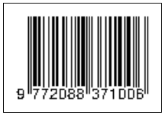Klasifikasi Kakao Berbasis e-nose dengan Metode Neuro Fuzzy
Ikhsan Nur Rahman(1*), Danang Lelono(2), Kuwat Triyana(3)
(1) Prodi Elektronika dan Instrumentasi, DIKE, FMIPA, UGM, Yogyakarta
(2) Departemen Ilmu Komputer dan Elektronika, FMIPA UGM, Yogyakarta
(3) Departemen Fisika, FMIPA UGM, Yogyakarta, Indonesia
(*) Corresponding Author
Abstract
During this time to clasify quality of cacao based on color and aroma involving human taster. But this cacao tester still has weaknesses such as subjective. Besides that, the standard chemical analytical methods requires a high cost and need expertise to analyzing it. Basically aroma of cacao is determined by volatile compounds such aldehid and alcohol. Electronic nose based on unselected gas sensor array has the ability to analyze samples with complex compositions that can be known characteristics and qualitative analysis of the samples. Stimulus aroma is transformed by electronic nose into fingerprint data then it is used by feature extraction process using the differential method. The results of feature extraction is used to process the neuro fuzzy training to obtain optimal parameters. The parameters have been optimized is then tested on cacao. Based on test results, neuro fuzzy can clasify samples with 95,21% accuracy rate so that the clasification of cacao quality with electronic nose using neuro fuzzy has been successfully carried out.
Keywords
Full Text:
PDFReferences
[1] M. E. Prawoto AA, “Pedoman Budi Daya Kakao pada Kebun Campur,” Bogor, Indones. World Agrofor. Cent. Southeast Asia Reg. Progr., 2014.
[2] Kemendag, “Rantai Nilai,” 2012. [Online]. Available: http://inatrims.kemendag.go.id/id/product/detail/rantai-nilai_1049/?market=ar. [Accessed: 25-Mar-2017].
[3] M. Idris, “Mentan Ingin RI Jadi Produsen Kakao Terbesar Kedua Dunia,” 2016. [Online]. Available: https://finance.detik.com/berita-ekonomi-bisnis/3127133/mentan-ingin-ri-jadi-produsen-kakao-terbesar-kedua-dunia. [Accessed: 25-Mar-2017].
[4] P. T. Wahyudi, T. R. Panggabean, Panduan Lengkap Kakao. Jakarta: Penebar Swadaya, 2008.
[5] D. Lelono, “Pengembangan Instrumentasi Sistem Electronic Nose untuk Uji Teh Hitam Lokal,” Universitas Gadjah Mada, 2017.
[6] S. Baskara, D. Lelono, and T. W. Widodo, “Pengembangan Hidung Elektronik untuk Klasifikasi Mutu Minyak Goreng dengan Metode Principal Component Analysis,” IJEIS (Indonesian J. Electron. Instrum. Syst., vol. 6, no. 2, p. 221, Oct. 2016 [Online]. Available: https://jurnal.ugm.ac.id/ijeis/article/view/15347. [Accessed: 30-May-2017]
[7] E. C. Alocija, N. L. Ritchie, and D. L. Grooms, “Protocol development using an electronic nose for differentiating E-coli strains,” IEEE Sens. J., vol. 3, no. 6, pp. 801–805, 2003.
[8] J. He, L. Xu, P. Wang, and Q. Wang, “A high precise E-nose for daily indoor air quality monitoring in living environment,” Integr. VLSI J., no. xxxx, pp. 1–10, 2016.
[9] N. Dufour, Y. Veyrac, P. Menini, F. Blanc, C. Talhi, B. Franc, C. Ganibal, P. Menini, N. Dufour, C. Wartelle, and K. Aguir, “Increasing the sensitivity and selectivity of Metal Oxide gas sensors by controlling the sensitive layer polarization,” Proc. IEEE Sensors, no. 2, pp. 3–6, 2012.
[10] G. Green, A. Chan, and R. Goubran, “Monitoring of food spoilage with electronic nose: potential applications for smart homes,” 2009 3rd Int. Conf. Pervasive Comput. Technol. Healthc., pp. 1–7, 2009.
[11] T. Seesaard, C. Sriphrapradang, T. Kitiyakara, and T. Kerdcharoen, “Self-screening for diabetes by sniffing urine samples based on a hand-held electronic nose,” 2016 9th Biomed. Eng. Int. Conf., pp. 1–4, 2016.
[12] C. K. Kit, A. C. Soh, U. Kalsom, M. Yusof, A. J. Ishak, and M. K. Hassan, “E-Nose Herbs Recognition System based on Artificial Neural Network Technique,” J. Control Syst. Comput. Eng., pp. 58–62, 2013.
[13] P. F. Qi, Q. H. Meng, Y. Q. Jing, M. Zeng, and S. G. Ma, “Rapid detection of Chinese liquors using a portable e-nose based on C-SVM,” Proc. World Congr. Intell. Control Autom., vol. 2016–Septe, pp. 1388–1392, 2016.
[14] C. Engineering and P. Thani, “Classification and pattern recognition algorithms applied to E-Nose,” no. Eict, pp. 44–48, 2015.
[15] H. R. Estakhroueiyeh and E. Rashedi, “Detecting moldy Bread using an E-nose and the KNN classifier,” 2015 5th Int. Conf. Comput. Knowl. Eng. ICCKE 2015, pp. 251–255, 2015.
[16] H. Yu, J. Wang, C. Yao, H. Zhang, and Y. Yu, “Quality grade identification of green tea using E-nose by CA and ANN,” vol. 41, pp. 1268–1273, 2008.
[17] R. Dutta, E. L. Hines, J. W. Gardner, K. R. Kashwan, and M. Bhuyan, “Tea quality prediction using a tin oxide-based electronic nose : an artificial intelligence approach,” vol. 94, pp. 228–237, 2003.
[18] M. Siadat and E. Losson, “Application of electronic nose to beer recognition using supervised artificial neural networks,” pp. 640–645, 2014.
[19] S. Singh, E. L. Hines, and J. Gardner, “Fuzzy neural computing of coffee and tainted-water data from an electronic nose,” Sensors Actuators B Chem., vol. 30, no. 3, pp. 185–190, 1996.
[20] X. Yue, Y. Guo, J. Wang, X. Mao, and X. Lei, “Water Pollution Forecasting Model of the Back-Propagation Neural Network Based on One Step Secant Algorithm,” vol. 105, 2010, pp. 458–464.
[21] S. Kusumadewi and S. Hartati, Neuro Fuzzy Integrasi Sistem Fuzzy & Jaringan Syaraf, 2nd ed. Yogyakarta: Graha Ilmu, 2010.
[22] W. Astuti, “Identifikasi Tahu Berformalin dengan Electronic Nose Menggunakan Jaringan Syaraf Tiruan Backpropagation,” vol. 6, no. 2, pp. 211–220, 2016.
Article Metrics
Refbacks
- There are currently no refbacks.
Copyright (c) 2018 IJEIS (Indonesian Journal of Electronics and Instrumentation Systems)

This work is licensed under a Creative Commons Attribution-ShareAlike 4.0 International License.
View My Stats1







